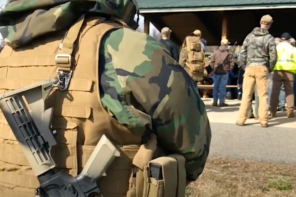Murder often functions as a cultural Rorschach test: the narratives we tell about why people kill often reveal more about ourselves than the killers.
The day before Halloween, 21-year-old Isaiah Marin of Stillwater, Oklahoma, murdered his 19-year-old friend, Jacob Crockett—nearly decapitating him with a machete. He turned himself in, rambling to the dispatcher about “magic and sacrifice.” The narrative that eventually formed was that Marin had been motivated by “strong Christian beliefs” and that he had attacked his friend for practicing witchcraft. The situation in Oklahoma demonstrates how media and the public select which factors are important in the aftermath of violence and raises important questions about what constitutes “religious” violence.
Oklahoma has been a very strange place lately and it’s understandable that Oklahomans have been struggling to make sense of it all. On September 21, a Satanic “black mass” was held in the Oklahoma civic center—drawing demonstrations from some 1600 Catholics and even an exorcism by Archbishop Paul S. Coakley.
Oklahoma City has also been the site of an ongoing controversy as The Satanic Temple (a different Satanic group) has campaigned to erect a monument to Satan on the grounds of the state capital to complement the current monument of the Ten Commandments. After Michael Tate Reed II rammed his car into the Ten Commandments monument on October 24, shattering it, the Satanic Temple released a statement condemning the destruction. Headlines initially described Reed as a Satanist, but he has now been identified as someone who suffers from severe mental illness. He’d actually declared his intention to go to Bible college in a recent Facebook post.
The October 30 decapitation also occurred one month after Alton Nolen, a convert to Islam, decapitated a co-worker in Moore, Oklahoma. Before converting to Islam, Nolan was already a convicted felon with a history of assault and drug use. He had also just been fired from Vaughan foods where the attack took place. The event was framed as an “Islamic” crime and many speculated on a connection to ISIS. In the days that followed, the Oklahoma chapter of the Council of American Islam Relations (CAIR) began receiving death threats, with one message threatening to behead the chapter’s director.
On Patheos, Oklahoma representative Rebecca Hamilton posted “eight points” about Nolen’s crime, in which she condemned apologists who, she claimed rushed to the defense of “Muslim extremists.” A conservative Catholic, Hamilton also implied that the murder might somehow be “an effect” of the black mass held in Oklahoma City.
Some have claimed that the responses to these crimes demonstrate a double-standard that excuses Christians while holding Muslims accountable. Humanist Michael Stone called the Marin decapitation an example of “Christian extremism.” Dan Savage sarcastically commented that Marin was merely acting out his “sincerely held religious beliefs”: He murdered his friend for practicing witchcraft in keeping with Exodus 22:18, “Thou shalt not suffer a witch to live.” Although insensitive, Savage’s commentary parodies anti-Islamic discourse that cherry-picks violent passages from the Quran and then asserts that the entire Muslim experience can be understood simply by sampling English translations of its texts.
Both cases demonstrate why violent crimes cannot be reduced to the religious affiliation of the perpetrator. As with Nolen, there were multiple factors that likely contributed to Marin’s situation, including the fact that he was described as a “heavy drug user.” Furthermore, in 1998, Marin’s father was murdered by a man dating his mother. His mother received a 12-year sentence for conspiracy to commit murder, though her conviction was overturned in 2008.
Conversely, police captain Randy Dickerson asserted that Marin’s religious beliefs were “not pertinent,” but this too seems overstated. Marin’s initial call to the police described sacrifice and magic. His Facebook posts also allude to having battles with demons. As with Nolen, Marin’s religion did not seem to cause him to behave violently, but it did seem to color how he understood his own violent impulses.
I admit that I am somewhat fascinated by stories of senseless crimes committed by adolescents. (See here and here). I find these cases all the more tragic because the motivations seem unknown, even to the perpetrators themselves. Without a motive, the media is free to construct whatever narrative it wants. In some cases, the perpetrators themselves will support these narratives, either in hopes of gaining leniency or because they too are in shock and susceptible to suggestion.
In his classic work Folk Devils and Moral Panic, sociologist Stanley Cohen described how, in the aftermath of a disaster, our natural psychological response is to create an “inventory” of associated factors. Unfortunately, because we do this instinctively rather than methodically, we tend to confuse correlation with causation. Instead of forming critical theories of why violence occurs, we rush to reduce complex events to facile narratives.
It’s hard to accept that we may never have a satisfactory explanation of why people suddenly decapitate their friends and coworkers. Instead, we subscribe to the logic of conspiracy theories. We attempt to construct a grand unified theory of evil, searching for connections to ISIS, black masses, and other dark forces. If there is any silver lining to this story, it may be that the bizarre coincidence of a Muslim and Christian decapitation occurring in the same state in the course of a month may cause us to reassess our inventories and think more carefully about the causes of (and the relationship of religion to) violence.




